 Sony Ericsson’s boffins have come up with the cunning idea of creating phones which automatically change the way they behave, depending on the time, date and place.
Sony Ericsson’s boffins have come up with the cunning idea of creating phones which automatically change the way they behave, depending on the time, date and place.
The cunning plan was revealed after the New Scientist magazine spotted a patent application by Sony Ericsson for a ‘System method and computer program product for managing themes in a mobile phone’.
Here’s the application abstract:
“Themes provide the mobile phone with changeable characteristics pertaining to the appearance and sound presented by the mobile phone. A theme profile associated with the mobile phone contains data pertaining to which theme to apply to the mobile phone and when to transition to another theme as well as where theme content data is located.
The mobile phone then waits for a triggering event to occur. When such a triggering event occurs, it causes a transition from the currently active theme to another theme. A new theme based on an associated triggering event is applied to the mobile phone changing its look and feel.”
What this means (in slightly less wordy language) is that the phone’s wallpaper display could automatically change to reflect dates logged in the calendar application of a user’s phone.
For example, the wallpaper display on the phone might automatically display a picture of a lovely big cake on the user’s birthday or a sparkling Christmas tree on December 25th.
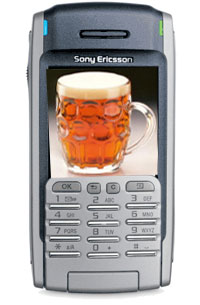 Travellers touching down in Glasgow airport may be ‘treated’ to a bagpipes ringtone courtesy of a GPS country location signal, or perhaps the phone might blast out some demonic black metal on arrival in the Norwegian hinterland.
Travellers touching down in Glasgow airport may be ‘treated’ to a bagpipes ringtone courtesy of a GPS country location signal, or perhaps the phone might blast out some demonic black metal on arrival in the Norwegian hinterland.
A more productive use of the technology could be in restaurants where a list of the day’s menu specials could be delivered direct to the phone’s screen via Bluetooth.
Another use may be in cinemas and theatres where Bluetooth could be used to automatically silence bleeping, ringing and ‘amusing’ ringtones.
The New Scientist article suggests that the feature could be used to keep stockbrokers updated with the latest share prices every 10 minutes or give walkers continually updated weather forecasts with the information being displayed as the phone’s wallpaper.
Happily, priority coding will let users override some automated controls, thus eliminating the prospect of a tinny rendition of KC and the Sunshine Band’s “That’s the Way (I Like It)” blasting out during granddad’s funeral.
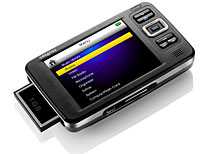 With the slap of a leather gauntlet against iPod’s shiny white face, Creative has unveiled its new Zen Vision a portable media player.
With the slap of a leather gauntlet against iPod’s shiny white face, Creative has unveiled its new Zen Vision a portable media player.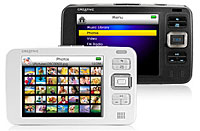 The Zen Vision supports a slew of video codecs, including AVI, DivX, XviD, MPEG-1, MPEG-2, MPEG4-SP and Microsoft’s WMV9.
The Zen Vision supports a slew of video codecs, including AVI, DivX, XviD, MPEG-1, MPEG-2, MPEG4-SP and Microsoft’s WMV9. Resplendent in its white or black finishes, the Zen is quite a looker, and is only slightly larger than the rival iPod.
Resplendent in its white or black finishes, the Zen is quite a looker, and is only slightly larger than the rival iPod.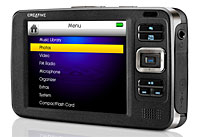 The pocket sized powerhouse comes with a rechargeable Li-ion battery offering up to 4.5 hours of video playback and 13 hours of audio, depending on the file’s format and energy settings.
The pocket sized powerhouse comes with a rechargeable Li-ion battery offering up to 4.5 hours of video playback and 13 hours of audio, depending on the file’s format and energy settings.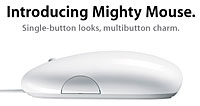 Apple has announced its latest product, the button-bedecked Mighty Mouse, revealing their first departure from the company’s traditional preference for single button input devices.
Apple has announced its latest product, the button-bedecked Mighty Mouse, revealing their first departure from the company’s traditional preference for single button input devices.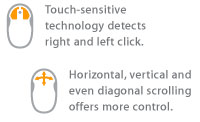 Apple’s stubborn refusal to include more than one button on its standard mouse has long brought scorn from the Windows community who were at a loss to understand why Mac users were being deprived of the clear productivity benefits of multi-buttoned mouses (Mice? Micii?)
Apple’s stubborn refusal to include more than one button on its standard mouse has long brought scorn from the Windows community who were at a loss to understand why Mac users were being deprived of the clear productivity benefits of multi-buttoned mouses (Mice? Micii?)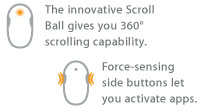 Naturally, Apple have added a little bit of pizzazz to the design, hiding the touch-sensitive technology under a plain shell. This detects which part of the mouse is being clicked, letting users left- and right-click.
Naturally, Apple have added a little bit of pizzazz to the design, hiding the touch-sensitive technology under a plain shell. This detects which part of the mouse is being clicked, letting users left- and right-click. Apple’s new feast of buttons will work on Mac OS X (programmability requires Mac OS X v10.4.2 Tiger or later) and Windows 2000 or Windows XP.
Apple’s new feast of buttons will work on Mac OS X (programmability requires Mac OS X v10.4.2 Tiger or later) and Windows 2000 or Windows XP.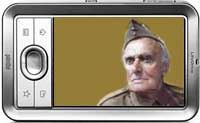 In spite of pundits’ predictions of a swift demise, the PDA refuses to die with 2005 looking set to be a record year for handheld sales.
In spite of pundits’ predictions of a swift demise, the PDA refuses to die with 2005 looking set to be a record year for handheld sales.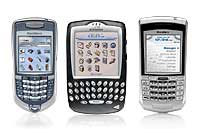 Like Billy Bunter at a speed eating competition, the Western European PDA market inflated by a massive 94 percent to reach 1.3 million units in the second quarter of 2005.
Like Billy Bunter at a speed eating competition, the Western European PDA market inflated by a massive 94 percent to reach 1.3 million units in the second quarter of 2005. New US research claims that Americans are becoming increasingly “digital,” with over three quarters owning computers and many households verily humming with multiple digital electronics products, including cell phones to entertainment devices to cameras.
New US research claims that Americans are becoming increasingly “digital,” with over three quarters owning computers and many households verily humming with multiple digital electronics products, including cell phones to entertainment devices to cameras. The research was commissioned by hard drive manufacturer, Seagate, who were keen to remind users of their role in the digital revolution:
The research was commissioned by hard drive manufacturer, Seagate, who were keen to remind users of their role in the digital revolution: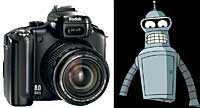 Kodak has announced a new class of ‘advanced digital cameras’ aimed at grabbing a slice of the burgeoning dSLR market.
Kodak has announced a new class of ‘advanced digital cameras’ aimed at grabbing a slice of the burgeoning dSLR market.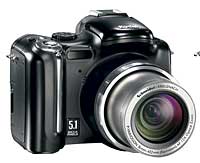 Looking down the range, Kodak have also announced their 5.3 megapixel EasyShare P850 camera, featuring a 12X, 36 – 432mm (35mm equiv.), f2.8 – f/3.7, Schneider-Kreuznach Variogon lens with optical image stabilisation.
Looking down the range, Kodak have also announced their 5.3 megapixel EasyShare P850 camera, featuring a 12X, 36 – 432mm (35mm equiv.), f2.8 – f/3.7, Schneider-Kreuznach Variogon lens with optical image stabilisation. The BBC’s online coverage of Live 8 in July notched up a record volume of Web traffic on their radio and music Websites.
The BBC’s online coverage of Live 8 in July notched up a record volume of Web traffic on their radio and music Websites.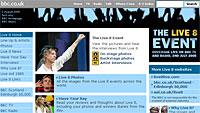 The latest figures for the BBC’s online traffic also show a healthy boost in figures for their sports coverage on the Radio Five Live Website, with 910,841 unique users being recorded during June, compared with 840,019 the same period in 2004.
The latest figures for the BBC’s online traffic also show a healthy boost in figures for their sports coverage on the Radio Five Live Website, with 910,841 unique users being recorded during June, compared with 840,019 the same period in 2004. It was mainly good news elsewhere, with Radio 1, Radio 2, Radio 3, Radio 4, 1Xtra, Asian Network and BBC 7 all increasing their unique users compared to the same period last year, with only 6 Music – one of our favourites – letting the side down with a disappointing slump from 418,729 to 356,564.
It was mainly good news elsewhere, with Radio 1, Radio 2, Radio 3, Radio 4, 1Xtra, Asian Network and BBC 7 all increasing their unique users compared to the same period last year, with only 6 Music – one of our favourites – letting the side down with a disappointing slump from 418,729 to 356,564. Hellomagazine.com, the online version of the ghastly celebrity magazine Hello!, is expanding its existing SMS and JAVA mobile offer with a new WAP portal.
Hellomagazine.com, the online version of the ghastly celebrity magazine Hello!, is expanding its existing SMS and JAVA mobile offer with a new WAP portal.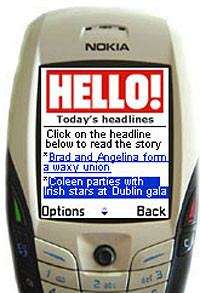 A bookmark directly linking to the portal will be sent by return, with users able to browse the latest headlines for free.
A bookmark directly linking to the portal will be sent by return, with users able to browse the latest headlines for free. Celeb-thirsty fans can check the headlines then go in deeper if they want the full story with photos. We’re really happy to be adding HELLO! WAP to our mobile offer and we’ll soon be beefing it up even more with wallpapers, ringtones and other entertaining stuff.”
Celeb-thirsty fans can check the headlines then go in deeper if they want the full story with photos. We’re really happy to be adding HELLO! WAP to our mobile offer and we’ll soon be beefing it up even more with wallpapers, ringtones and other entertaining stuff.”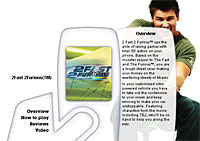 Mobile gaming big boys I-Play have released the results of a study which revealed that only 5% of mobile users have ever downloaded a game
Mobile gaming big boys I-Play have released the results of a study which revealed that only 5% of mobile users have ever downloaded a game A further 17.5% were uncertain how to download a game while the rest said that the downloading process itself was tedious.
A further 17.5% were uncertain how to download a game while the rest said that the downloading process itself was tedious. Pricing was seen as a discouraging factor by 51% of the respondents, with 48 percent in favour of free trail versions and 30% saying that that they would go for a game if a friend recommended it.
Pricing was seen as a discouraging factor by 51% of the respondents, with 48 percent in favour of free trail versions and 30% saying that that they would go for a game if a friend recommended it. Like Popeye with a mouthful of spinach, broadband providers Easynet have barged BT out of the way to claim a lucrative three-year deal to supply wholesale broadband services to Onetel, Centrica’s telecommunications division.
Like Popeye with a mouthful of spinach, broadband providers Easynet have barged BT out of the way to claim a lucrative three-year deal to supply wholesale broadband services to Onetel, Centrica’s telecommunications division. Ian El-Mokadem, Managing Director, Onetel sounded chuffed with the deal: “The partnership with Easynet will allow us to deploy next generation broadband services and benefit from Local Loop Unbundling economics. The market is set to evolve rapidly and we wanted a partner that could demonstrate experience in the local loop, and a willingness to work in a true partnership.
Ian El-Mokadem, Managing Director, Onetel sounded chuffed with the deal: “The partnership with Easynet will allow us to deploy next generation broadband services and benefit from Local Loop Unbundling economics. The market is set to evolve rapidly and we wanted a partner that could demonstrate experience in the local loop, and a willingness to work in a true partnership.